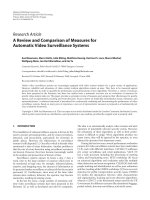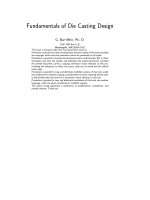Fundamentals of Wireless Communication potx
Bạn đang xem bản rút gọn của tài liệu. Xem và tải ngay bản đầy đủ của tài liệu tại đây (1.24 MB, 76 trang )
Fundamentals of
Wireless Communication
David Tse
Dept of EECS
U.C. Berkeley
Course Objective
•
Past decade has seen a surge of research activities in
the field of wireless communication.
•
Emerging from this research thrust are new points of
view on how to communicate effectively over wireless
channels.
•
The goal of this course is to study in a unified way the
fundamentals as well as the new research
developments.
•
The concepts are illustrated using examples from
several modern wireless systems (GSM, IS-95, CDMA
2000 1x EV-DO, Flarion's Flash OFDM, ArrayComm
systems.)
Course Outline
Day 1: Fundamentals
1. The Wireless Channel
2. Diversity
3. Capacity of Wireless Channels
Course Outline (2)
Day 2: MIMO
4. Spatial Multiplexing and Channel Modelling
5. Capacity and Multiplexing Architectures
6. Diversity-Multiplexing Tradeoff
Course Outline (3)
Day 3: Wireless Networks
7. Multiple Access and Interference Management: A
comparison of 3 systems.
8. Opportunistic Communication and Multiuser Diversity
9. MIMO in Networks
1. The Wireless Channel
Wireless Mulipath Channel
Channel varies at two spatial scales:
large scale fading
small scale fading
Large-scale fading
•
In free space, received power attenuates like 1/r
2
.
•
With reflections and obstructions, can attenuate even
more rapidly with distance. Detailed modelling
complicated.
•
Time constants associated with variations are very long
as the mobile moves, many seconds or minutes.
•
More important for cell site planning, less for
communication system design.
Small-scale multipath fading
•
Wireless communication typically happens at very high
carrier frequency. (eg. f
c
= 900 MHz or 1.9 GHz for
cellular)
•
Multipath fading due to constructive and destructive
interference of the transmitted waves.
•
Channel varies when mobile moves a distance of the
order of the carrier wavelength. This is 0.3 m for Ghz
cellular.
•
For vehicular speeds, this translates to channel variation
of the order of 100 Hz.
•
Primary driver behind wireless communication system
design.
Game plan
•
We wish to understand how physical parameters such as
carrier frequency, mobile speed, bandwidth, delay
spread impact how a wireless channel behaves from the
communication system point of view.
•
We start with deterministic physical model and progress
towards statistical models, which are more useful for
design and performance evaluation.
Physical Models
•
Wireless channels can be modeled as linear time-
varying systems:
where a
i
(t) and τ
i
(t) are the gain and delay of path i.
•
The time-varying impulse response is:
•
Consider first the special case when the channel is time-
invariant:
Passband to Baseband Conversion
•
Communication takes place at [f_c-W/2, f_c+ W/2].
•
Processing takes place at baseband [-W/2,W/2].
Baseband Equivalent Channel
•
The frequency response of the system is shifted from the
passband to the baseband.
•
Each path is associated with a delay and a complex
gain.
Sampling
Multipath Resolution
Sampled baseband-equivalent channel model:
where h
l
is the l th complex channel tap.
and the sum is over all paths that fall in the delay bin
System resolves the multipaths up to delays of 1/W .
Flat and Frequency-Selective Fading
•
Fading occurs when there is destructive interference of
the multipaths that contribute to a tap.
Time Variations
f
c
τ
i
’(t) = Doppler shift of the i th path
Two-path Example
v= 60 km/hr, f_c = 900 MHz:
direct path has Doppler shift of + 50 Hz
reflected path has shift of - 50 Hz
Doppler spread = 100 Hz
Types of Channels
Statistical Models
•
Design and performance analysis based on statistical
ensemble of channels rather than specific physical
channel.
•
Rayleigh flat fading model: many small scattered paths
Complex circular symmetric Gaussian .
•
Rician model: 1 line-of-sight plus scattered paths
Correlation over Time
•
Specifies by autocorrelation
function and power spectral
density of fading process.
•
Example: Clarke’s (or Jake’s)
model.
Additive Gaussian Noise
•
Complete baseband-equivalent channel model:
•
Will use this throughout the course.
2. Diversity









